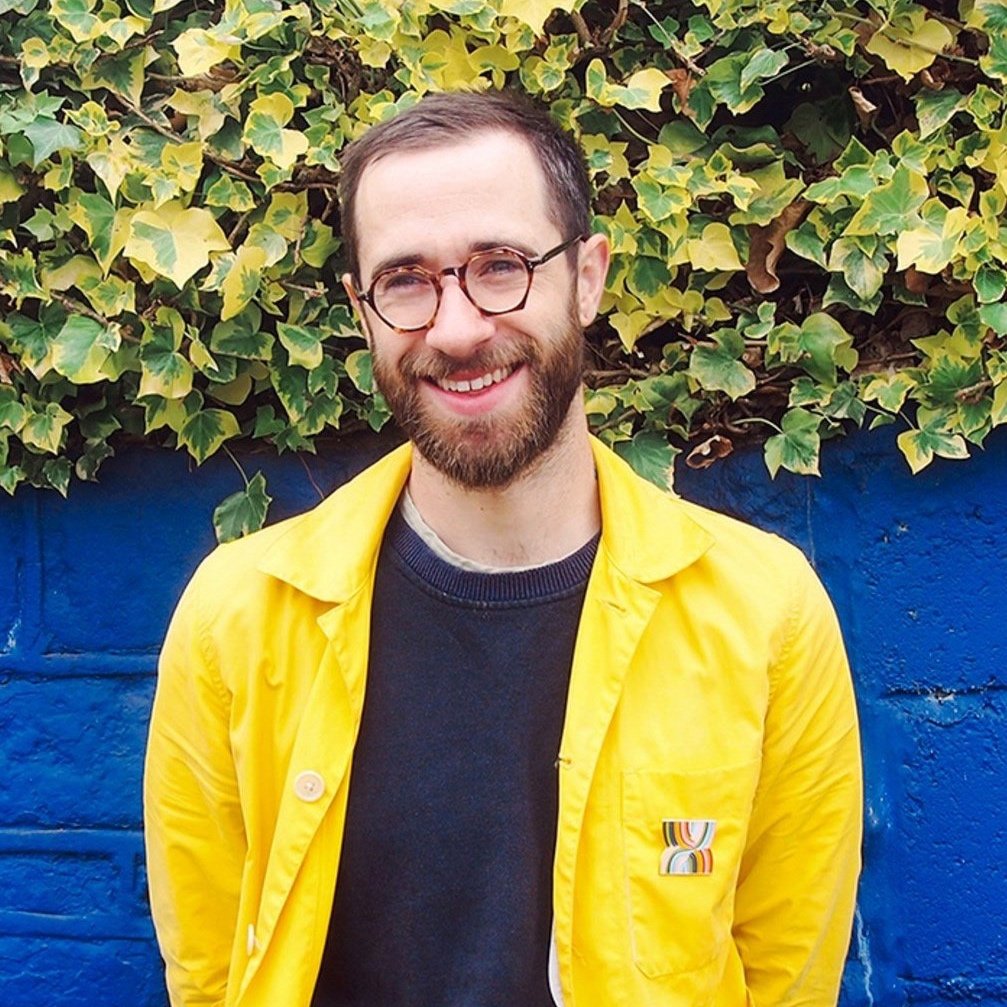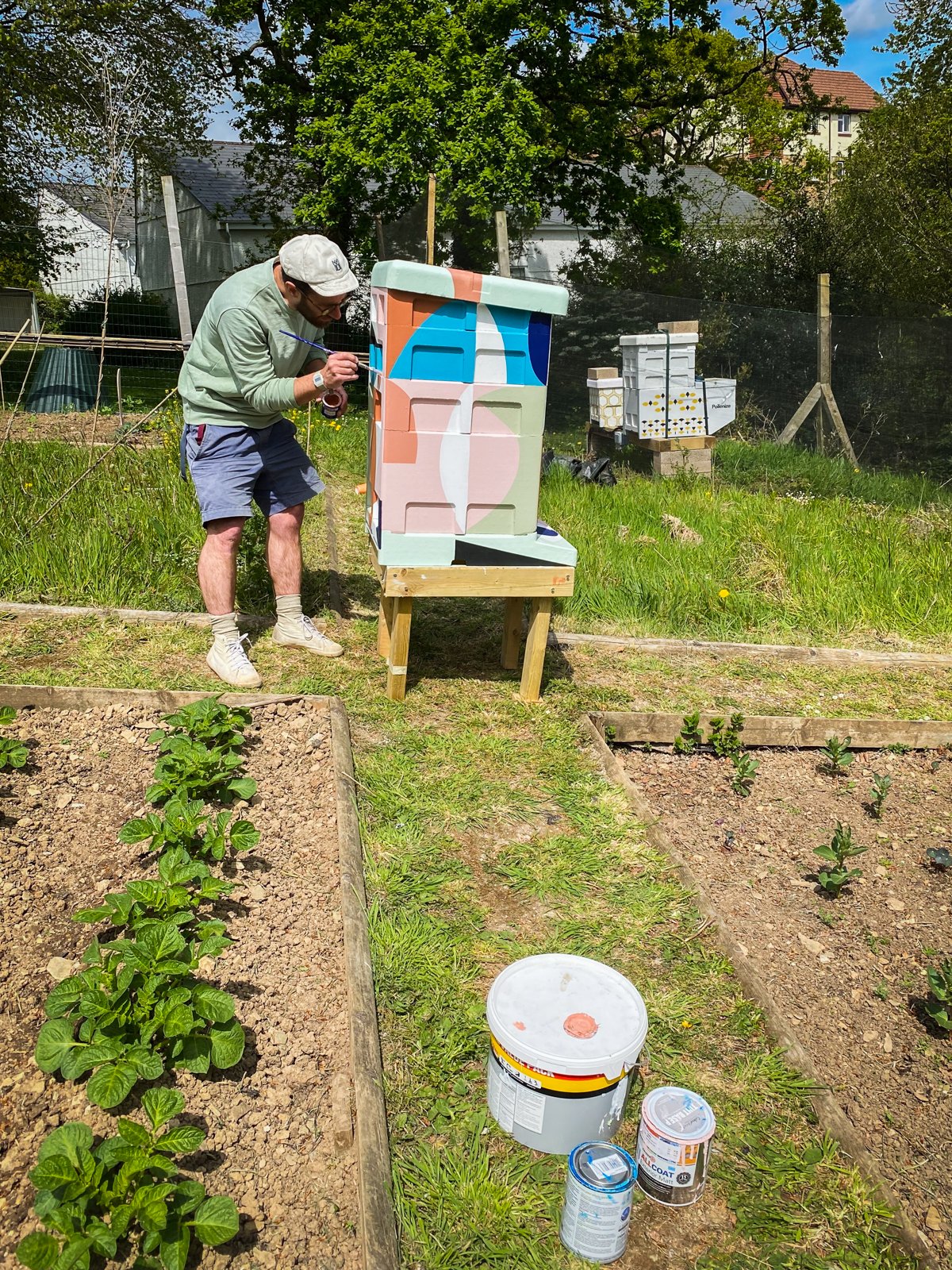Who’s been painting our hives at Marjons?
At Pollenize, we’re always keen to call upon the local community within Plymouth to amplify our important mission of pollinator conservation. Over the years, a wide range of inspiring creatives have helped to transform the beehives dotted around the city into spectacular colourful homes for our bees.
Last year, in proud partnership with Marjon University, we expanded the Plymouth apiary network to include a new site within their campus allotment, which sits just adjacent to the student village. This was all part of our united efforts to conserve and extend local populations of the native dark honey bee. Recently, Marjon Arts Centre put out an open call seeking local artists who would be interested in a commissioned project to design and paint a Pollenize beehive!
Several applications were considered but there was one proposal from Artist William Luz which secured him the role of our beehive artist. William has created work for Aesop, The Barbican, Nike, and Facebook. He has exhibited in shows internationally and is one-third of Nous Vous, a collective of artists who have been working together since 2007. If you are local to Plymouth you may already be familiar with his magnificent creations, one of which is the enormous wall mural that can be seen as you walk up Union St, designed and installed by Will in collaboration with Stephen Smith of Neasden Control Centre, and commissioned by Nudge Community Builders.
We visited Will in the allotment as he worked his magic on the hive. Now completed, it is now inhabited by its own colony of honey bees.
Let's introduce you to the artist…
Hi Will! You were based in London before moving with your young family down to Plymouth where you’ve certainly made a positive mark on the local culture. How have you found this shift of lifestyle and what is it about Plymouth/southwest that inspires you and your work?
There’s a shift in focus down here that could be interpreted as a lack in some way, but for me it’s a rejection of certain attributes of life that can feel like the sacrifice you make when you live in the metropolis. We weren’t sure it needed to be that, sure, there are sacrifices we might have made leaving London but the gains have far outweighed. For me, that’s essentially the sea. I swim a few times a week, it helped locate me here, through lockdowns it kept me level and I would struggle not to live so close now. I may not take specific inspiration from living here in the way that others do, from say the landscape, but the extra time afforded from not rushing around and being so stretched helps me think with greater clarity and depth, generally if I’m happier I make more work that I’m happy about. Also, I’m really excited to have the kids grow up so at ease with being next to the sea and finding pleasure from the elements.
The world of an artist is incredibly varied and full of wonderfully bizarre briefs, what was it about the open call to paint a Pollenize Beehive that appealed to you?
In all honesty the life of an artist is also pretty precarious so you often seek out any and all appropriate opportunities that make it possible to continue. Having said that, I would not take on something I did not believe in. I really like the part of my job that allows me to meet new people and learn about new things as I like researching and thinking about the content my work will be put in. I definitely haven’t painted a hive before but was aware of the artist-designed hives Pollenize had commissioned previously so it was nice to be part of that community. I’m also really keen to learn about and get involved with local initiatives that are doing good things around our area. For sure, this kind of ethos is definitely very visible and seems to be prevalent down here and it feels very good to be around that and when feeling positive, be part of it. It’s an inspiration to think we can all do little bits to make things less bad and hopefully avoid some sort of complete climate breakdown.
We love the finished piece! You have a very distinctive style in the way you express yourself through shapes and thoughtful colour schemes. Can you tell us a little bit about your concept for the beehive? Did you have an idea about how you wanted it to look beforehand?
Thanks! I’m really happy with it too! My work is about finding a balanced and tightly composed set of abstract shapes that looks quite effortless but I think would topple if an element was removed. For the hive, as is often the case, I spent some time up at the allotment looking and noticing and drawing the shapes around then took them back to work them into a composition. I wanted to quite simply express how a community (like the bees and university and the human/non human) is made up of different elements and forms but they all fit together and all have their own place and are all as important as each other to the whole. This is also reflected in the painted wooden shapes that are dotted and half hidden around the allotment, to hint at the less visible aspects that make up a positive community. I especially like working in 3D as it gives you the ability to create a flow as you imagine someone walking around the piece. The design was fully sketched up before I started but with a bit of wriggle room so the design could flex a bit through the painting.
You were extremely lucky with a run of fair weather during your time painting in Marjon University’s allotment, how did you find your office setting for the week?
Could have been a lot worse! Although my initial idea was to paint the hive in situ, when Owen recommended that might not be such a great idea due to the hive that already exists there and that the bees might not make painting that easy. I moved a few metres away and apart from the odd bee and butterfly I remained quite unbothered. It’s such a great spot up there for a small university. The architecture is strange and it is flanked by green and apparently regularly has animals visiting from the moors.
Marjon University is rolling out lots of amazing sustainability initiatives to become a zero-carbon campus by 2030. Thousands of our native honeybees have now moved into their snazzy new hive.
Collaborative projects like this not only help to showcase the work of amazing artists like yourself, but it also helps to spread our important messages about pollinator conservation. Do you enjoy contributing to sustainable initiatives in the community?
For sure, this kind of ethos is definitely very visible and seems to be prevalent down here and it feels very good to be around that and be part of it. It’s an inspiration to think we can all do little bits to make things less bad and hopefully avoid some sort of complete climate breakdown.






